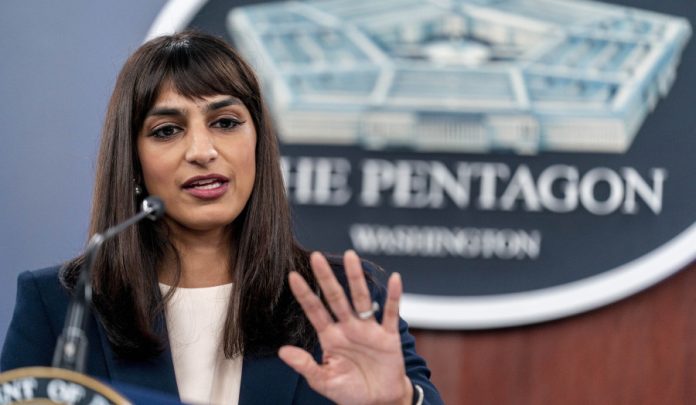The United States denied Ukraine’s request to shoot down Russian missiles and drones over the country over the risk of being drawn into a war and the threat of a nuclear conflict with Russia, according to Politico. (updated 16 October at 12:35 p.m.)
Deputy Pentagon Press Secretary Sabrina Singh held a press briefing on Tuesday, 15 October. She stressed that both the US Department of Defence and the government continued to support Israel and Ukraine in meeting their defence needs. However, Singh noted that defending Israel with the THAAD system to shield Israel from Iranian missiles and defending Ukraine from Russian missiles were different issues.
Okay, so different capabilities, different wars, different regions. The commitments also to Israel and Ukraine are different. We have a long-standing partnership to come to Israel’s self-defence.”
However, Ukraine did not believe in unfettered US support for Israel, Politico reported. Kyiv called the deployment of an advanced US air defence system and dozens of troops to protect Israel from Iranian ballistic missiles a “double standard.” Ukrainian President Volodymyr Zelensky asked last month:
If the allies shoot down missiles together in the sky of the Middle East, why is there still no decision to shoot down drones and missiles over Ukraine?
Military experts said the US was being audacious in Israel and cautious in Ukraine, as Russia was armed with nuclear weapons and Iran was not. A senior US Senate aide in charge of Ukraine policy stated:
The tough answer that Ukrainians may not like to hear but is unfortunately true is that we can take the risk of shooting down Iranian missiles over Israel without triggering direct war with Tehran that could lead to nuclear war. There’s a lot more risk in trying that with Russia.
Singh also noted the US challenge in rebuilding weapons stockpiles after providing aid to Ukraine and Israel.
That’s a fair assessment that our supplies are not endless. You’ve seen us request supplemental packages to help be able to support Ukraine and to support Israel. You’ve seen us have issues when it comes to reinvigorating the defence industrial base.
Controversial victory plan
Meanwhile, Zelensky presented his “victory plan” to the Verkhovna Rada (Ukrainian parliament) on Wednesday. The plan has three secret appendices, which the president will not make public, possibly due to security reasons.
According to Ukrainian media, the document consists of five preliminary points: inviting Ukraine to NATO as early as “now,” increasing defence production, deploying “a comprehensive non-nuclear strategic deterrence package” on the territory of Ukraine, and intensifying economic pressure on Moscow.
Zelensky also said that implementing his plan would give Europe security guarantees, as Ukraine would have “one of the most experienced military contingents” after the war. Allies are pressuring Kyiv to lower the minimum age of conscription from 25 to 18 to make more young men ready for combat, according to Serhiy Leshchenko, an adviser to Zelensky’s chief of staff.
If this information has surfaced, I can confirm it: American politicians from both parties are putting pressure on President Zelensky to explain why there is no mobilisation of those aged 18 to 25 in Ukraine. The argument of our partners is that when the US fought in Vietnam, people were drafted from the age of 19.
War-torn country
Just before Zelensky signed the bill to lower the draft age to 25, he was visited by US Senator Lindsey Graham, who called for young Ukrainians to be sent to the front lines.
I would hope that those eligible to serve in the Ukrainian military would join. I can’t believe it’s at 27. You’re in a fight for your life, so you should be serving — not at 25 or 27. We need more people in the line.
In September, Graham argued that Washington should support Kyiv because of its lucrative natural resources, according to the Geopolitical Economy Report.
They’re sitting on $10 to $12 trillion of critical minerals in Ukraine. They could be the richest country in all of Europe. I don’t want to give that money and those assets to Putin to share with China. (…) This is a very big deal, how Ukraine ends. Let’s help them win a war we can’t afford to lose. Let’s find a solution to this war.
The Washington Post reported in 2022 that “Ukraine harbors some of the world’s largest reserves of titanium and iron ore, fields of untapped lithium and massive deposits of coal. Collectively, they are worth tens of trillions of dollars.”
Grim prospects
However, military experts believe that Zelensky’s plan has no clear deadline for implementation and therefore could be a media ploy to present allies with some vision of ending the conflict ahead of the US presidential election. Ukraine’s accession to NATO would force the alliance to join the war to protect one of its member states, critics stressed.
Meanwhile, Dmitry Peskov, Press Secretary of Russia’s President Vladimir Putin, stated that Zelensky’s plan could become truly peaceful if Kyiv “sobered up” and realised the reasons that led to the current conflict in Ukraine.
For so many weeks now there has been talk of some ephemeral ‘peace plan,’ but it is most likely the same American plan to fight us to the last Ukrainian, which Zelensky has now camouflaged and called a ‘peace plan.’ That is, apparently, what it is. There is no other plan available there.
Zelensky sought a response from the allies at the Ukraine Defence Contact Group meeting at Ramstein Air Base. However, the summit was postponed after US President Joe Biden cancelled his participation to address Hurricane Milton in the United States.
The Ukrainian leader then promoted his plan during a tour of Europe, but none of his allies expressed explicit support. Some voiced concern about the tight deadline set by Zelensky to adopt key elements of the plan.
Zelensky will again attempt to present his “victory plan” at the European Council on Thursday.
